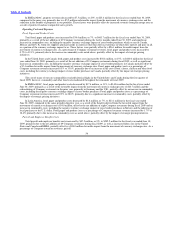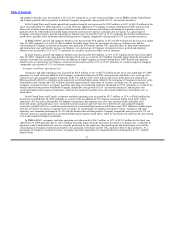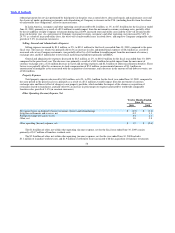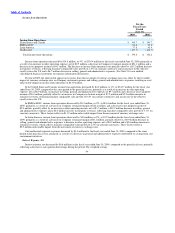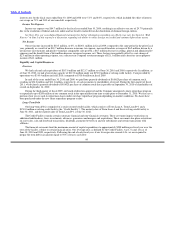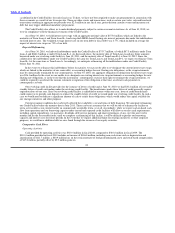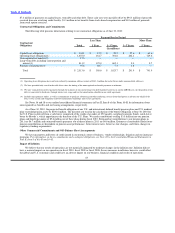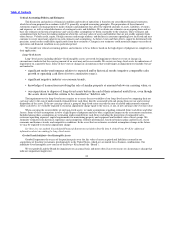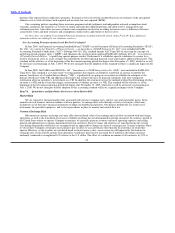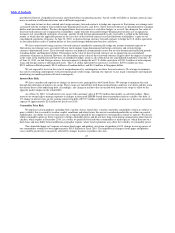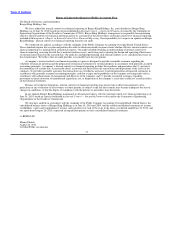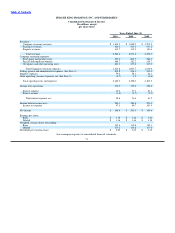Burger King 2010 Annual Report Download - page 68
Download and view the complete annual report
Please find page 68 of the 2010 Burger King annual report below. You can navigate through the pages in the report by either clicking on the pages listed below, or by using the keyword search tool below to find specific information within the annual report.
Table of Contents
portion of the expected losses under these programs. Insurance reserves have been recorded based on our estimates of the anticipated
ultimate costs to settle all claims, both reported and incurred−but−not−reported (IBNR).
Our accounting policies regarding these insurance programs include judgments and independent actuarial assumptions about
economic conditions, the frequency or severity of claims and claim development patterns and claim reserve, management and
settlement practices. Since there are many estimates and assumptions involved in recording insurance reserves, differences between
actual future events and prior estimates and assumptions could result in adjustments to these reserves.
See Note 22 to our audited Consolidated Financial Statements included in Part II, Item 8 of this Form 10−K for additional
information about accounting for our insurance reserves.
New Accounting Pronouncements Issued But Not Yet Adopted
In June 2009, the Financial Accounting Standards Board (“FASB”) issued Statement of Financial Accounting Standards (“SFAS”)
No. 166, “Accounting for Transfers of Financial Assets — an Amendment of FASB Statement No. 140” (now included in FASB
Accounting Standards Codification (“ASC”) Subtopic 860−20). This standard amends ASC Topic 860 by removing the concept of a
qualifying special−purpose entity (“QSPE”) and eliminates the exception from applying FASB ASC Subtopic 810−10, “Consolidation
of Variable Interest Entities,” to qualifying special−purpose entities. Furthermore, it establishes specific conditions to account for a
transfer of financial assets as a sale, changes the requirements for derecognizing financial assets and requires additional disclosure. This
standard will be effective as of the beginning of the first annual reporting period that begins after November 15, 2009, which for us will
be our fiscal year beginning on July 1, 2010. We do not anticipate that the adoption of this standard will have a significant impact on the
Company.
In June 2009, the FASB issued SFAS No. 167, “Amendments to FASB Interpretation No. 46(R)” (now included in FASB ASC
Topic 810). This standard is a revision to pre−existing guidance that requires an enterprise to perform an analysis to identify the
primary beneficiary of a Variable Interest Entity (“VIE”), a qualitatively on−going re−assessment on whether the enterprise is the
primary beneficiary of the VIE and additional disclosures that will provide users of financial statements with more transparent
information about an enterprise’s involvement in a VIE. In addition, this statement revises the methods utilized for determining whether
an entity is a VIE and the events that trigger a reassessment of whether an entity is a VIE. This standard will be effective as of the
beginning of the first annual reporting period that begins after November 15, 2009, which for us will be our fiscal year beginning on
July 1, 2010. We do not anticipate that the adoption of this accounting standard will have a significant impact on the Company.
Item 7A. Quantitative and Qualitative Disclosures About Market Risk
Market Risk
We are exposed to financial market risks associated with currency exchange rates, interest rates and commodity prices. In the
normal course of business and in accordance with our policies, we manage these risks through a variety of strategies, which may
include the use of derivative financial instruments to hedge our underlying exposures. Our policies prohibit the use of derivative
instruments for speculative purposes, and we have procedures in place to monitor and control their use.
Currency Exchange Risk
Movements in currency exchange rates may affect the translated value of our earnings and cash flow associated with our foreign
operations, as well as the translation of net asset or liability positions that are denominated in foreign currencies. In countries outside of
the United States where we operate Company restaurants, we generally generate revenues and incur operating expenses and selling,
general and administrative expenses denominated in local currencies. These revenues and expenses are translated using the average
rates during the period in which they are recognized and are impacted by changes in currency exchange rates. In many countries where
we do not have Company restaurants our franchisees pay royalties to us in currencies other than the local currency in which they
operate. However, as the royalties are calculated based on local currency sales, our revenues are still impacted by fluctuations in
exchange rates. In fiscal 2010, income from operations would have decreased or increased $12.5 million if all foreign currencies
uniformly weakened or strengthened 10% relative to the U.S. dollar. The effect of a uniform movement of all currencies by 10% is
66


